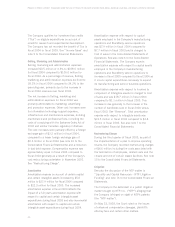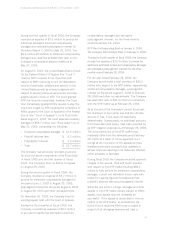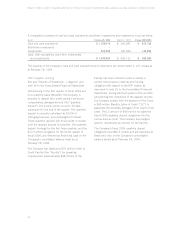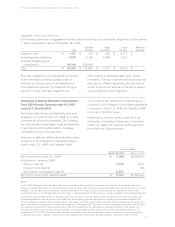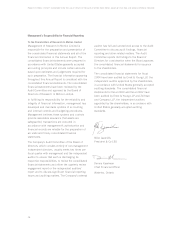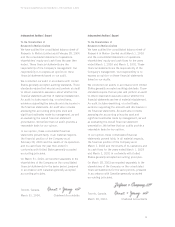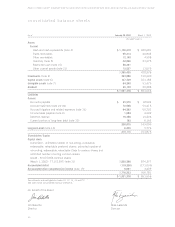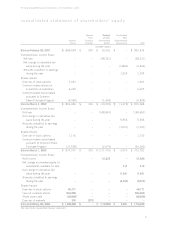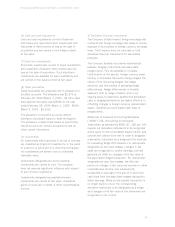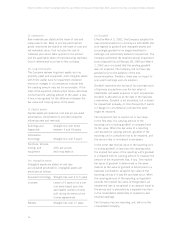Blackberry 2004 Annual Report Download - page 28
Download and view the complete annual report
Please find page 28 of the 2004 Blackberry annual report below. You can navigate through the pages in the report by either clicking on the pages listed below, or by using the keyword search tool below to find specific information within the annual report.
26
Research In Motion Limited • Incorporated Under the Laws of Ontario (In thousands of United States dollars, except per share data, and except as otherwise indicated)
Market Risk of Financial Instruments
The Company is engaged in operating and financing
activities that generate risk in three primary areas:
Foreign Exchange
The Company is exposed to foreign exchange risk as
a result of transactions in currencies other than its
functional currency of the U.S. dollar. The majority
of the Company’s revenues in fiscal 2004 are
transacted in U.S. dollars, Canadian dollars, Euros
and British pounds. Purchases of raw materials are
primarily transacted in U.S. dollars. Other expenses,
consisting of the majority of salaries, certain
operating costs and all manufacturing overhead, are
incurred primarily in Canadian dollars. At February
28, 2004, approximately 2% of cash and cash
equivalents, 26% of trade receivables and 18% of
accounts payable and accrued liabilities are
denominated in foreign currencies (March 1, 2003 -
14%, 13%, and 8%, respectively). These foreign
currencies include the Canadian dollar, British
pound, Euro, Australian dollar, Hong Kong dollar,
and Japanese yen.
To mitigate a portion of this risk, the Company
maintains net monetary asset and/or liability
balances in foreign currencies and engages in
foreign currency hedging activities using derivative
financial instruments. The Company does not
purchase or hold any derivative instruments for
speculative purposes.
To hedge exposures relating to foreign currency
anticipated transactions, the Company has entered
into forward foreign exchange contracts to sell U.S.
dollars and purchase Canadian dollars, to sell Euro
and purchase U.S. dollars, and to sell British
pounds and purchase U.S. dollars. These contracts
have been designated as cash flow hedges, with the
resulting changes in fair value recorded as other
comprehensive income, and subsequently
reclassified to earnings in the period in which the
cash flows from the associated hedged transactions
affect earnings. These cash flow hedges were fully
effective at February 28, 2004. As at February 28,
2004, the unrealized gain on these forward
contracts was approximately $5,468 (March 1,
2003 - $3,439). These amounts were included in
Other current assets and Other comprehensive
income.
To hedge exposure relating to foreign currency
denominated long-term debt, the Company has
entered into forward foreign exchange contracts to
sell U.S. dollars and purchase Canadian dollars.
These contracts have been designated as fair value
hedges, with gains and losses on the hedge
instruments being recognized in earnings each
period, offsetting the change in the U.S. dollar value
of the hedged liability. As at February 28, 2004, a
loss of $69 was recorded in respect of this amount
(March 1, 2003 - gain of $419). This amount was
included with Selling, marketing and administration.
Interest Rate
Cash, cash equivalents and investments are invested
in certain instruments of varying short-term maturities.
Consequently, the Company is exposed to interest
rate risk as a result of holding investments of
varying maturities. The fair value of investments,
as well as the investment income derived from the
investment portfolio, will fluctuate with changes in
prevailing interest rates. The Company does not
currently use interest rate derivative financial
instruments in its investment portfolio.
Credit and Customer Concentration
RIM has historically been dependent on a small but
increasing number of significant customers and on
large complex contracts with respect to sales of the
majority of its products. The Company expects this
trend to continue as it sells an increasing number of
its products and service relay access through
network carriers and resellers rather than directly.
The Company is undergoing significant sales growth
in North America and internationally, resulting in
the growth in its carrier customer base in terms of
numbers, sales and trade receivables volumes and
in some instances new or significantly increased
credit limits. The Company, in the normal course of
business, monitors the financial condition of its






